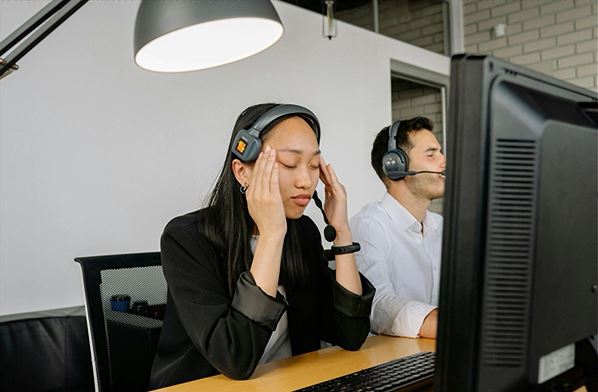
As a customer service manager, you know just how crucial it is to take good care of your team.
Employee wellbeing equates to happier and more productive representatives who provide better customer service, and it also means you can keep working with top talent for longer.
That’s why it’s important to ensure they work in comfortable environments and stay in good physical health. Though you can do that by opening communication channels, balancing their workloads, and even offering perks like gym memberships, you’ll want to pay especially close attention to their eyes.
To get their jobs done, your team members need to look at computers for the majority of the work day—and, as is the case with other British employees, that makes them vulnerable to eye strain. This condition happens when the eyes focus on something for too long. That eventually tires them, leading to pain, discomfort, and reduced employee wellbeing. In fact, Workplace Insight found that it’s one of the main reasons why the UK’s workers become unproductive—costing the country’s economy over £1.8 trillion a year.
That said, you may want to help your team avoid or relieve eye strain. These tips can get you started:
Encourage regular screen breaks
According to Specsavers, there’s a lack of screen breaks in UK offices. As many as four in ten workers tend to use computers for more than two hours at a time. The retailer’s respondents also cited working on screens as the most tiring activity they do. These findings are likely the result of eye strain. They hint at potential decreases in wellbeing and productivity—and their prevalence shows that your team may be experiencing the same issues, too.
To address these concerns, many opticians recommend following the 20-20-20 rule. Have your team look away from their screens at least every 20 minutes so they can look at something 20 feet away for 20 seconds. However, Specsavers also found that 84% of employees still work for longer than 20 minutes, which is why you may want to help them build the habit by gently reminding them to take breaks or asking them to use timers. It can also help to encourage socialisation during lunch breaks, as it will prevent your team from turning to their personal devices—which are still also digital displays—during this time.
Reduce blue light exposure
Though primarily emitted by the sun, blue light can also come from electronic devices. In moderation, it can improve memory and focus. However, too much of it can overwhelm the eyes with glare, straining them and causing symptoms like dryness, headaches, and blurred vision that distract your team from their work. Given how long customer service professionals use computers during office hours, their eyes can easily succumb to overexposure. That’s why you may want to reduce how much blue light their eyes absorb.
You can start by recommending that they get blue light glasses. These types of glasses shield against strong light to reduce any strain and improve visual comfort. Glasses Direct uses BlueReflect lenses on their glasses, specifically designed to block reflections from digital screens, making them perfect for customer service representatives. On your end, you can cut your team’s exposure even further by installing blue light filters on your office computers. You can get these from Ocushield, which makes the world’s first medically-rated screen protectors for blocking blue light wavelengths.
Redesign your workspace
As mentioned above, comfort is paramount for bolstering your team’s wellbeing. That makes ergonomic design vital if you want to prevent eye strain. Though it’s not immediately apparent, this condition is caused not just by how long the eyes look at something, but the way they’re viewing it. Simple issues like a computer screen being too bright or dark compared to their surroundings, poor posture, and computers placed too high or low can cause the eyes to strain just to see what’s on it.
Ergonomic design principles can help because they revolve around maximising comfort—and thus efficiency—in the workplace. Make sure your team works in a well-lit area. Use computer stands to keep screens at eye level. You can even furnish your team with ergonomic chairs, which come with cushiony seats and curved backrests that keep users comfortable while supporting natural spine alignment. These will help keep your team from straining their eyes when working—while also preventing them from lapsing into unproductivity due to neck or back pain. Though redesigning your workspace in this way can be pricey, it’ll be worth the investment if you’re truly committed to eliminating eye strain and ultimately improving your team’s wellbeing.




